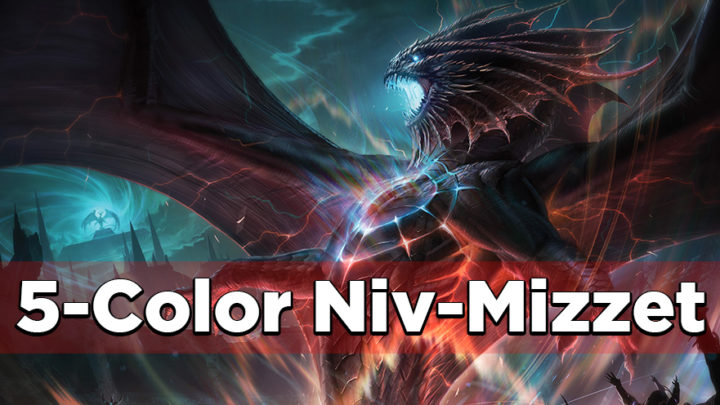Five-Color Niv-Mizzet is both one of the hottest decks in Pioneer and my personal favorite deck in the format. This deck can interact with your opponent with a wide array of disruptive spells until you can resolve a creature that generates value, such as Niv-Mizzet Reborn. The key is to get ahead on resources and then use those resources to win the game.
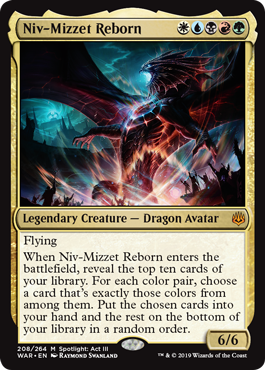
The Pioneer metagame has evolved quite a bit over the past few months. Mono-Black Aggro dominated early; “Chonky” Red midrange decks emerged to counter it; Rakdos Midrange went one step bigger than that; and 5-Color Niv-Mizzet is the biggest of them all. Historically, if you’re playing a format full of midrange decks, it’s best to play the biggest midrange deck — and Pioneer is no exception.
Today, let’s talk about the deck sitting atop Pioneer’s grind factory and how best to build it.
Building the Main Deck
When you’re playing a five-color deck that rewards you for diversifying your card choices, there seem to be tons of options for deck-building. That assessment is both right and wrong. While 5-Color Niv may seem like a deck with 40 flex spots, the core of the deck is bigger than you think.
Here are the must-have cards for the deck:
3 Niv-Mizzet Reborn
4 Bring to Light
4 Sylvan Caryatid
2 Paradise Druid
4 Teferi, Time Raveler
2 Abrupt Decay
1 Supreme Verdict
1 Utter End
2 Uro, Titan of Nature’s Wrath
2 Siege Rhino
26 Lands
That’s 51 cards, which leaves us with only nine flex slots. There are also some cards I didn’t include here — such as Dreadbore, Unmoored Ego, and Cut // Ribbons — that are pretty close to standard.
Here’s the main deck I played this past weekend to a 10-2 record. I’d like to credit the folks over at Lotus Box for the mana base — they put a ton of work into it, and the deck ran quite smoothly.
5-Color Niv-Mizzet by Michael Rapp
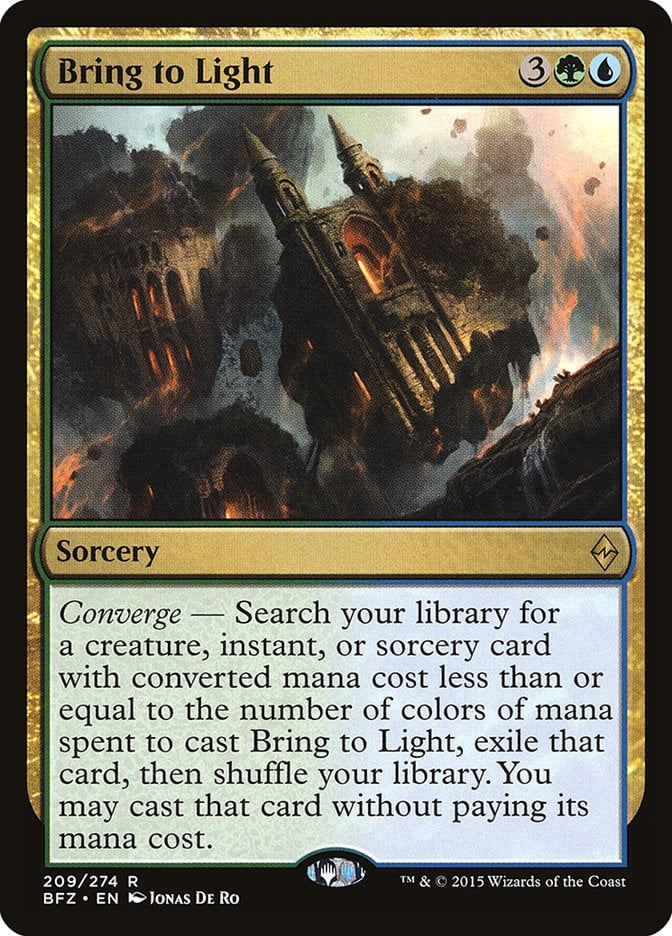
2 Paradise Druid
4 Sylvan Caryatid
1 Dreadbore
2 Abrupt Decay
4 Teferi, Time Raveler
1 Unmoored Ego
1 Deafening Clarion
3 Uro, Titan of Nature’s Wrath
1 Supreme Verdict
1 Utter End
1 Nahiri, the Harbinger
3 Siege Rhino
1 The Scarab God
1 Tolsimir, Friend to Wolves
4 Bring to Light
3 Niv-Mizzet Reborn
1 Cut // Ribbons
2 Botanical Sanctum
4 Fabled Passage
1 Forest
1 Godless Shrine
1 Island
2 Mana Confluence
1 Mountain
2 Opulent Palace
1 Overgrown Tomb
1 Plains
2 Sandsteppe Citadel
2 Spirebluff Canal
2 Stomping Ground
1 Swamp
2 Temple Garden
1 Watery Grave
That makes my choice of flex slots:
1 Dreadbore
1 Unmoored Ego
1 Deafening Clarion
1 Uro, Titan of Nature’s Wrath
1 Nahiri, the Harbinger
1 Siege Rhino
1 The Scarab God
1 Tolsimir, Friend to Wolves
1 Cut // Ribbons
As you can see, I went into the weekend ready for aggressively-slanted creature decks, like Mono-Red and Mono-Black. I packed an extra four removal spells if you count Tolsimir, and three creatures that gain life. The preparation only got me so far, as the metagame turned out to be full of midrange and control strategies. Azorius Spirits was the most popular creature deck of the weekend, which makes sense given the number of Azorius Control decks floating around.
If you’re looking for an edge in the mirror and against Azorius Control, you could replace some of the removal spells with additional Dreadbores, Paradise Druids, Thoughtseizes, and the fourth Niv-Mizzet Reborn. Tuning your flex slots to the expected metagame is one of the biggest benefits and challenges when it comes to playing this deck.
Building the Sideboard
Building the sideboard is all about targeting troublesome match-ups while keeping your Niv hits high. My sideboard was as follows:
4 Rest in Peace
1 Blood Baron of Vizkopa
1 Kaya, Orzhov Usurper
1 Despark
1 Rakdos’s Return
2 Infernal Reckoning
2 Thoughtseize
1 Thought Distortion
1 Golgari Charm
1 Slaughter Games
This sideboard targets graveyard decks like Soulflayer, Dredge-less Dredge, and Underworld Breach, along with Mono-Black Aggro, Izzet Ensoul, and Azorius Control.
Rest in Peace
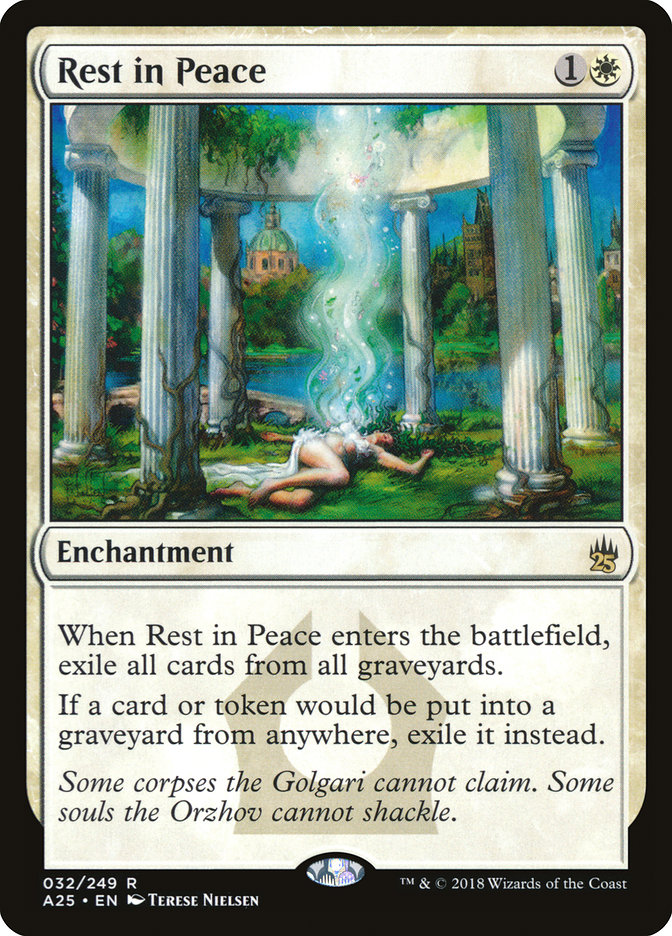
Rest in Peace is a mainstay as long as Soulflayer is popular. Underworld Breach can be solved with Damping Sphere, but given that Rest in Peace also gets the job done in that match-up, it earns the full four sideboard slots.
Blood Baron & Kaya

Blood Baron of Vizkopa and Kaya, Orzhov Usurper are both primarily for Mono-Black Aggro, but also pull their weight against Azorius Control.
Despark

Despark is a good way to handle Planeswalkers out of Azorius Control, big threats out of Green Ramp decks, and a Soulflayer without hexproof.
Rakdos’s Return
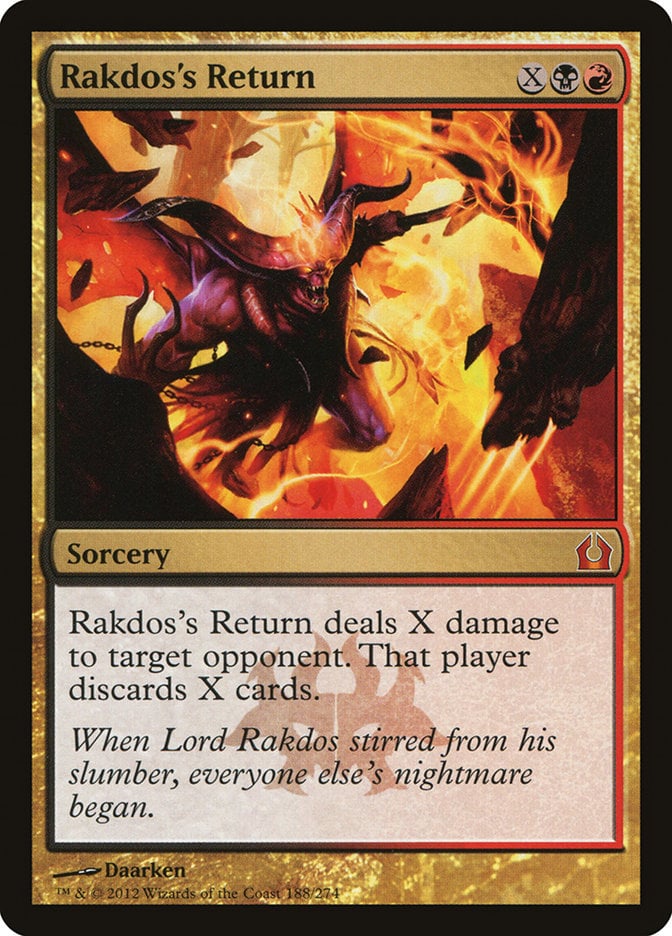
Rakdos’s Return is an all-star against Azorius Control, the mirror, and any other grindy deck that might have some cards saved up in the mid-game.
Infernal Reckoning

Infernal Reckoning is mostly for Izzet Ensoul, as it is our only way to kill a Stonecoil Serpent outside of Supreme Verdict. Reckoning also has value against any of the Scrapheap Scrounger + Mutavault aggro decks.
Discard Spells

Thoughtseize comes in against the mirror, Azorius Control, and any combo decks such as Underworld Breach. Thought Distortion is lights out against Azorius Control, while being a reasonable option against combo decks.
Golgari Charm

Golgari Charm does an excellent job at combating both the Underworld Breach + Chronic Flooding plan and Young Pyromancer tokens. With enough targets in both Izzet Ensoul and Mono-Black Aggro, Golgari Charm has exceeded my expectations.
Slaughter Games

Slaughter Games is primarily for Underworld Breach, but will likely win the game in the mirror if you name Niv-Mizzet. It also gives you a good amount of game against any other combo decks you may run across.
Bringing the Truth to Light
Now that we have an idea of what 5-Color Niv decks can look like, I wanted to go over some deck-building misconceptions that I’ve both experienced and heard about from other players.
Myth #1: Multicolored cards are better than mono-colored cards that serve similar functions.
While keeping your multicolored card count relatively high will make your Niv-Mizzet draw more cards on average, it may very well make the rest of your deck weaker. Thoughtseize vs. Thought Erasure is a good example. While the mana base produces the colors it needs fairly consistently, it often comes at the price of speed. Tapped land into tapped land isn’t an uncommon start, making a Thought Erasure on turn three a lot less impactful. By playing Thoughtseize, we can play a tapped land and still cast Thoughtseize on turn two to effectively disrupt our opponent.
Myth #2: Mana creatures water down the deck too much.
While there’s some truth to this statement, I believe you should play more mana sources than you think you’ll need. In Limited, you’ll sometimes choose to play an extra land because you’re most likely to lose if you can’t cast your most powerful spells; the same is true of 5-Color Niv. The card quality of a deck with as many gold spells as this one is much higher than most other decks in Pioneer, so you want to try and eliminate the risk of stumbling on mana.
I believe the correct number of mana sources is either 33-35, with the split likely being 27 lands and seven mana creatures. This should give you the requisite number of mana sources without diluting the multicolored card count too much. Having a mana creature on turn two is key to your best starts: it enables turn four Niv-Mizzet, which will often put your opponent under tremendous pressure.
Myth #3: You should always use Bring to Light to find Niv-Mizzet.
While this is frequently true, I found myself using Bring to Light to bail myself out of tricky situations by finding Supreme Verdict, Deafening Clarion, Utter End, and even Infernal Reckoning all weekend. Niv-Mizzet is a powerful card advantage spell, but sometimes you need to dig through your toolbox and find an answer.
Changes for the Future
I’ve played 5-Color Niv a fair amount now, and I’ve gotten a feel for which cards consistently over- and under-perform. Here’s how I’d build the deck going forward:
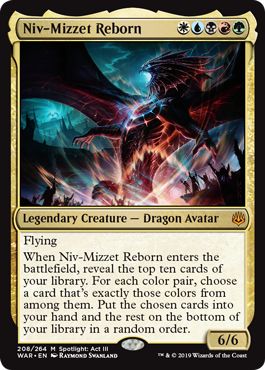
3 Paradise Druid
4 Sylvan Caryatid
1 Dreadbore
2 Abrupt Decay
4 Teferi, Time Raveler
1 Unmoored Ego
1 Deafening Clarion
2 Uro, Titan of Nature’s Wrath
1 Supreme Verdict
1 Utter End
1 Nahiri, the Harbinger
2 Siege Rhino
1 Tolsimir, Friend to Wolves
4 Bring to Light
4 Niv-Mizzet Reborn
1 Cut // Ribbons
2 Botanical Sanctum
1 Breeding Pool
4 Fabled Passage
1 Forest
1 Godless Shrine
1 Island
2 Mana Confluence
1 Mountain
2 Opulent Palace
1 Overgrown Tomb
1 Plains
2 Sandsteppe Citadel
2 Spirebluff Canal
2 Stomping Ground
1 Swamp
2 Temple Garden
1 Watery Grave
Sideboard:
4 Rest in Peace
2 Infernal Reckoning
1 Golgari Charm
2 Thoughtseize
1 Rakdos’s Return
1 Thought Distortion
1 Kaya, Orzhov Usurper
3 Mystical Dispute
This version of the deck cuts some of the flex spots for a 27th land and a 7th mana creature to boost speed and consistency. I’ve also cut come of the under-performing gold cards from the sideboard in favor of three copies of Mystical Dispute to give us some additional points in the tough Azorius Control match-up.
While a number of talented players have put a lot of time into testing this deck, I don’t think it’s even close to being fully refined. I, for one, am excited to see what players at the first round of Player’s Tour events bring to the table. As always, if you have any thoughts on this deck guide, be sure to let me know on Twitter at @RappaciousOne!

Michael Rapp is a Modern specialist who favors Thoughtseize decks. Magic sates his desire for competition and constant improvement.

